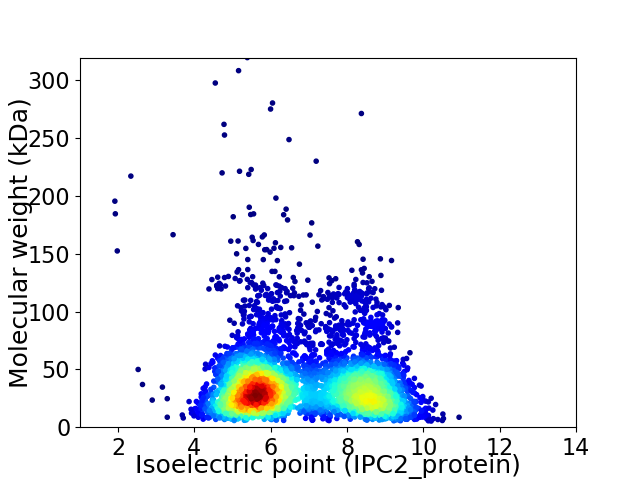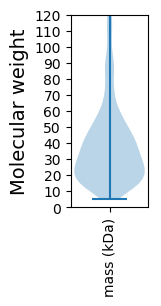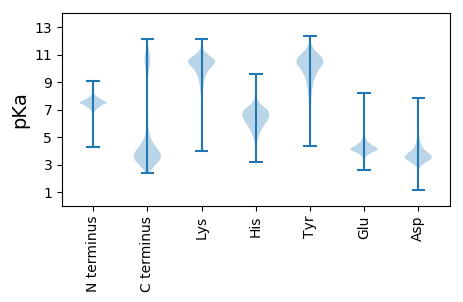
Flavihumibacter petaseus NBRC 106054
Taxonomy: cellular organisms; Bacteria; FCB group; Bacteroidetes/Chlorobi group; Bacteroidetes; Chitinophagia; Chitinophagales; Chitinophagaceae; Flavihumibacter; Flavihumibacter petaseus
Average proteome isoelectric point is 6.78
Get precalculated fractions of proteins

Virtual 2D-PAGE plot for 4759 proteins (isoelectric point calculated using IPC2_protein)
Get csv file with sequences according to given criteria:
* You can choose from 21 different methods for calculating isoelectric point
Summary statistics related to proteome-wise predictions



Protein with the lowest isoelectric point:
>tr|A0A0E9N733|A0A0E9N733_9BACT Putative two-component response regulator OS=Flavihumibacter petaseus NBRC 106054 OX=1220578 GN=FPE01S_05_02010 PE=4 SV=1
LL1 pKa = 7.08PATVTIDD8 pKa = 3.33QPAVLTASAAGDD20 pKa = 4.27DD21 pKa = 4.13VTCYY25 pKa = 10.41NAANGTITVSSPTGGSGEE43 pKa = 4.06FEE45 pKa = 3.88FRR47 pKa = 11.84INGGTWQEE55 pKa = 3.77GLVFSNLAPDD65 pKa = 4.4TYY67 pKa = 10.9TIDD70 pKa = 4.4IRR72 pKa = 11.84DD73 pKa = 4.02KK74 pKa = 11.32NNPLCIVTLPEE85 pKa = 4.36TVTIDD90 pKa = 3.43QPAVLSASAAGDD102 pKa = 3.59DD103 pKa = 3.97VTCFNAANGKK113 pKa = 8.28ITVSSPTGGSGEE125 pKa = 4.1YY126 pKa = 10.05EE127 pKa = 3.76FRR129 pKa = 11.84INGGTWQEE137 pKa = 3.77GLVFSNLAPDD147 pKa = 4.4TYY149 pKa = 10.9TIDD152 pKa = 3.71IRR154 pKa = 11.84DD155 pKa = 4.11KK156 pKa = 9.98NTPACIVTLPGTVTIDD172 pKa = 3.31QPAVLSASAAGDD184 pKa = 4.18DD185 pKa = 4.02VTCYY189 pKa = 10.42NAANGKK195 pKa = 8.28ITVSSPTGGSGEE207 pKa = 4.1YY208 pKa = 10.05EE209 pKa = 3.76FRR211 pKa = 11.84INGGTT216 pKa = 3.2
LL1 pKa = 7.08PATVTIDD8 pKa = 3.33QPAVLTASAAGDD20 pKa = 4.27DD21 pKa = 4.13VTCYY25 pKa = 10.41NAANGTITVSSPTGGSGEE43 pKa = 4.06FEE45 pKa = 3.88FRR47 pKa = 11.84INGGTWQEE55 pKa = 3.77GLVFSNLAPDD65 pKa = 4.4TYY67 pKa = 10.9TIDD70 pKa = 4.4IRR72 pKa = 11.84DD73 pKa = 4.02KK74 pKa = 11.32NNPLCIVTLPEE85 pKa = 4.36TVTIDD90 pKa = 3.43QPAVLSASAAGDD102 pKa = 3.59DD103 pKa = 3.97VTCFNAANGKK113 pKa = 8.28ITVSSPTGGSGEE125 pKa = 4.1YY126 pKa = 10.05EE127 pKa = 3.76FRR129 pKa = 11.84INGGTWQEE137 pKa = 3.77GLVFSNLAPDD147 pKa = 4.4TYY149 pKa = 10.9TIDD152 pKa = 3.71IRR154 pKa = 11.84DD155 pKa = 4.11KK156 pKa = 9.98NTPACIVTLPGTVTIDD172 pKa = 3.31QPAVLSASAAGDD184 pKa = 4.18DD185 pKa = 4.02VTCYY189 pKa = 10.42NAANGKK195 pKa = 8.28ITVSSPTGGSGEE207 pKa = 4.1YY208 pKa = 10.05EE209 pKa = 3.76FRR211 pKa = 11.84INGGTT216 pKa = 3.2
Molecular weight: 22.18 kDa
Isoelectric point according different methods:
Protein with the highest isoelectric point:
>tr|A0A0E9N0S3|A0A0E9N0S3_9BACT Uncharacterized protein OS=Flavihumibacter petaseus NBRC 106054 OX=1220578 GN=FPE01S_02_07180 PE=4 SV=1
MM1 pKa = 7.66RR2 pKa = 11.84NAIAFACQIPRR13 pKa = 11.84EE14 pKa = 4.35NILPATRR21 pKa = 11.84LEE23 pKa = 3.94DD24 pKa = 4.75LIPVRR29 pKa = 11.84RR30 pKa = 11.84RR31 pKa = 11.84QSIVKK36 pKa = 9.96KK37 pKa = 10.49INTLLGLRR45 pKa = 11.84LINLSITDD53 pKa = 4.04RR54 pKa = 11.84LALTWLITTVCSLTLFFISWKK75 pKa = 10.31LAVSCLLINFSAIWLSVKK93 pKa = 8.44MAKK96 pKa = 9.98LFQMEE101 pKa = 4.5TVGALARR108 pKa = 11.84HH109 pKa = 5.86FAWHH113 pKa = 6.7NYY115 pKa = 5.27RR116 pKa = 11.84TARR119 pKa = 11.84RR120 pKa = 11.84DD121 pKa = 3.31PASYY125 pKa = 10.58NPRR128 pKa = 11.84EE129 pKa = 4.11VTPFLINAFTSHH141 pKa = 6.94FDD143 pKa = 3.43IDD145 pKa = 4.51PKK147 pKa = 10.9TLTADD152 pKa = 3.18TRR154 pKa = 11.84LL155 pKa = 3.47
MM1 pKa = 7.66RR2 pKa = 11.84NAIAFACQIPRR13 pKa = 11.84EE14 pKa = 4.35NILPATRR21 pKa = 11.84LEE23 pKa = 3.94DD24 pKa = 4.75LIPVRR29 pKa = 11.84RR30 pKa = 11.84RR31 pKa = 11.84QSIVKK36 pKa = 9.96KK37 pKa = 10.49INTLLGLRR45 pKa = 11.84LINLSITDD53 pKa = 4.04RR54 pKa = 11.84LALTWLITTVCSLTLFFISWKK75 pKa = 10.31LAVSCLLINFSAIWLSVKK93 pKa = 8.44MAKK96 pKa = 9.98LFQMEE101 pKa = 4.5TVGALARR108 pKa = 11.84HH109 pKa = 5.86FAWHH113 pKa = 6.7NYY115 pKa = 5.27RR116 pKa = 11.84TARR119 pKa = 11.84RR120 pKa = 11.84DD121 pKa = 3.31PASYY125 pKa = 10.58NPRR128 pKa = 11.84EE129 pKa = 4.11VTPFLINAFTSHH141 pKa = 6.94FDD143 pKa = 3.43IDD145 pKa = 4.51PKK147 pKa = 10.9TLTADD152 pKa = 3.18TRR154 pKa = 11.84LL155 pKa = 3.47
Molecular weight: 17.82 kDa
Isoelectric point according different methods:
Peptides (in silico digests for buttom-up proteomics)
Below you can find in silico digests of the whole proteome with Trypsin, Chymotrypsin, Trypsin+LysC, LysN, ArgC proteases suitable for different mass spec machines.| Try ESI |
 |
|---|
| ChTry ESI |
 |
|---|
| ArgC ESI |
 |
|---|
| LysN ESI |
 |
|---|
| TryLysC ESI |
 |
|---|
| Try MALDI |
 |
|---|
| ChTry MALDI |
 |
|---|
| ArgC MALDI |
 |
|---|
| LysN MALDI |
 |
|---|
| TryLysC MALDI |
 |
|---|
| Try LTQ |
 |
|---|
| ChTry LTQ |
 |
|---|
| ArgC LTQ |
 |
|---|
| LysN LTQ |
 |
|---|
| TryLysC LTQ |
 |
|---|
| Try MSlow |
 |
|---|
| ChTry MSlow |
 |
|---|
| ArgC MSlow |
 |
|---|
| LysN MSlow |
 |
|---|
| TryLysC MSlow |
 |
|---|
| Try MShigh |
 |
|---|
| ChTry MShigh |
 |
|---|
| ArgC MShigh |
 |
|---|
| LysN MShigh |
 |
|---|
| TryLysC MShigh |
 |
|---|
General Statistics
Number of major isoforms |
Number of additional isoforms |
Number of all proteins |
Number of amino acids |
Min. Seq. Length |
Max. Seq. Length |
Avg. Seq. Length |
Avg. Mol. Weight |
|---|---|---|---|---|---|---|---|
0 |
1741998 |
50 |
2989 |
366.0 |
40.85 |
Amino acid frequency
Ala |
Cys |
Asp |
Glu |
Phe |
Gly |
His |
Ile |
Lys |
Leu |
|---|---|---|---|---|---|---|---|---|---|
8.272 ± 0.035 | 0.832 ± 0.011 |
5.34 ± 0.023 | 5.417 ± 0.039 |
4.742 ± 0.025 | 7.444 ± 0.037 |
1.928 ± 0.017 | 6.352 ± 0.025 |
5.722 ± 0.034 | 9.605 ± 0.041 |
Met |
Asn |
Gln |
Pro |
Arg |
Ser |
Thr |
Val |
Trp |
Tyr |
|---|---|---|---|---|---|---|---|---|---|
2.341 ± 0.018 | 4.917 ± 0.035 |
4.381 ± 0.027 | 3.994 ± 0.022 |
4.836 ± 0.029 | 6.192 ± 0.031 |
5.834 ± 0.052 | 6.481 ± 0.022 |
1.468 ± 0.014 | 3.901 ± 0.024 |
Most of the basic statistics you can see at this page can be downloaded from this CSV file
Proteome-pI is available under Creative Commons Attribution-NoDerivs license, for more details see here
| Reference: Kozlowski LP. Proteome-pI 2.0: Proteome Isoelectric Point Database Update. Nucleic Acids Res. 2021, doi: 10.1093/nar/gkab944 | Contact: Lukasz P. Kozlowski |
